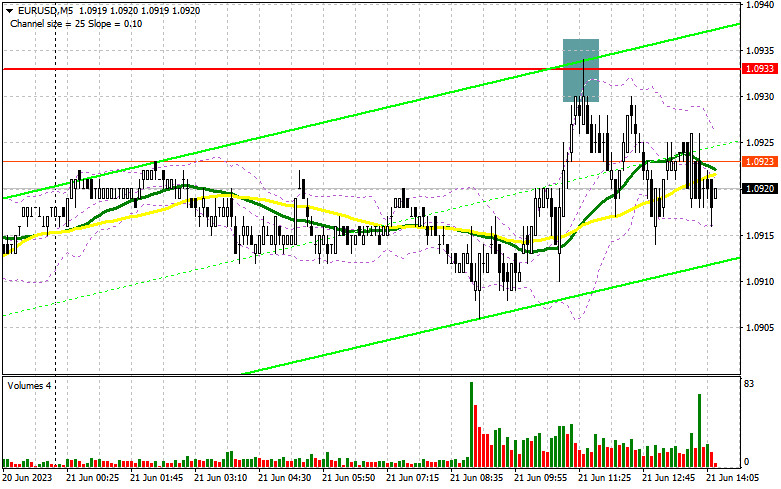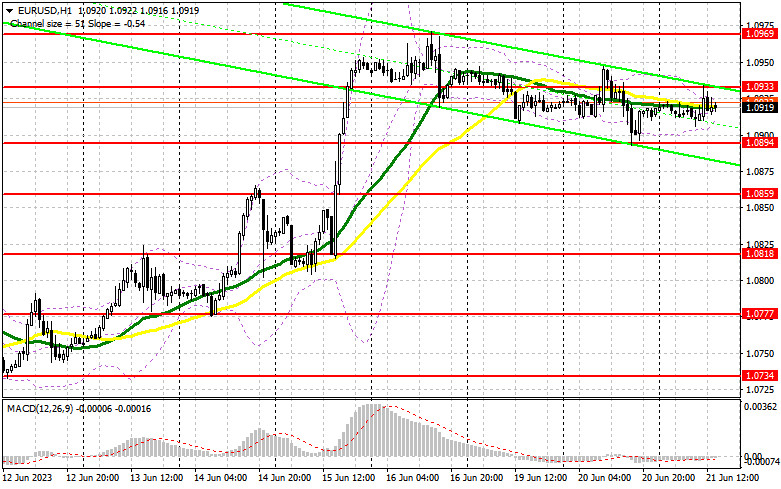

Long positions on EUR/USD:
Everyone is awaiting the speech from Federal Reserve Chairman Jerome Powell, who is expected to shed light on future central bank policy. However, we may not hear anything new. Regardless, a softer and dovish stance from the Fed's head could stimulate the euro's rise. If such an event does not occur, and market participants deduce a certainty of at least two interest rate hikes in the future, the EUR/USD pair may continue its correction, especially as it remained below 1.0933, unable to surpass yesterday's peak.
From the bulls' viewpoint, the best course of action aligns with the morning scenario: a false breakout at 1.0894 would signal a buy, allowing a return to the 1.0933 resistance level, which the pair failed to pierce today. Breaching and testing this level from above would increase demand for the euro, giving it a chance to reach 1.0969. The next target remains at 1.1029, where traders may take profits. If the EUR/USD pair declines and no buyers emerge at 1.0894 in the afternoon, bears might become more active, hoping for a downward correction. So, a false breakout near the next support at 1.0859 would create a buy signal for the euro. You may open long positions on a rebound from the low of 1.0818, allowing an upward intraday correction of 30-35 pips.
Short positions on EUR/USD:
Bears did not let the pair go above 1.0933. However, it is too early to talk about any significant market changes. It seems that bulls are just waiting for more attractive prices and counting on a significant drop in the euro in the medium term is unlikely, especially after today's statements from European Central Bank representatives who unanimously stressed the need for a fight against inflation.

For this reason, it would be better to open positions on the rise and false breakout around the 1.0933 resistance. Failing to consolidate there, the pair may give a sell signal, pushing the price to 1.0894. A break below this level, coupled with a reverse test from below, may drag the pair to 1.0859. The next target will be at the low of 1.0818, where traders are likely to take profits. If the EUR/USD pair moves up during the US session and there are no bears at 1.0933, bulls can take control of the market. In that case, it would be better to postpone short positions until the price reaches the next resistance at 1.0969. One may sell the euro there only after a failed consolidation. You can also open short positions on a rebound from the high of 1.1029, allowing a downward correction of 30-35 pips.
The COT report for June 13 showed a reduction in both long and short positions. However, this report was released before the Federal Reserve's decision on interest rates, which remained unchanged in June of this year. This significantly influenced the balance of power in the market. Therefore, there is no need to pay special attention to the current report. More importantly, the demand for the euro remained amidst the ongoing aggressive policy by the European Central Bank and will continue. In current conditions, buying on dips will be the optimal medium-term strategy. The COT report shows that non-commercial long positions decreased by 9,922 to 226,138, while non-commercial short positions fell by 3,323 to 74,316. As a result, the total non-commercial net position decreased to 151,822 from 158,224. The weekly closing price rose to 1.0794 from 1.0702.
Signals of indicators:
Moving averages
The pair is trading near the 30- and 50-day moving averages, indicating market uncertainty.
Note: Period and prices of moving averages are considered by the author on hourly chart H1 and differ from the common definition of classic daily moving averages on daily chart D1.
Bollinger Bands
In the case of growth, the upper band of the indicator near 1.0920 wil offer resistance.
Description of indicators
Moving average defines the current trend by smoothing out volatility and noise. Period 50. Marked in yellow on the chart.Moving average defines the current trend by smoothing out volatility and noise. Period 30. Marked in green on the chart.MACD (Moving Average Convergence/Divergence) indicator. Fast EMA 12. Slow EMA 26. SMA 9Bollinger Bands. Period 20Non-commercial traders are speculators, such as individual traders, hedge funds, and large institutions, which use the futures market for speculative purposes and meet certain requirements.Long non-commercial positions represent the total long open position of non-commercial traders.Short non-commercial positions represent the total short open position of non-commercial traders.Total non-commercial net position is the difference between short and long positions of non-commercial traders.